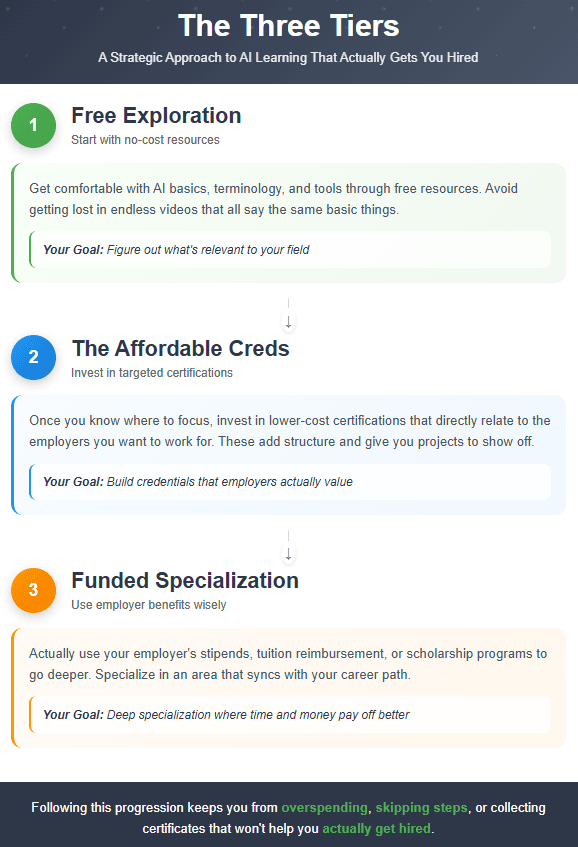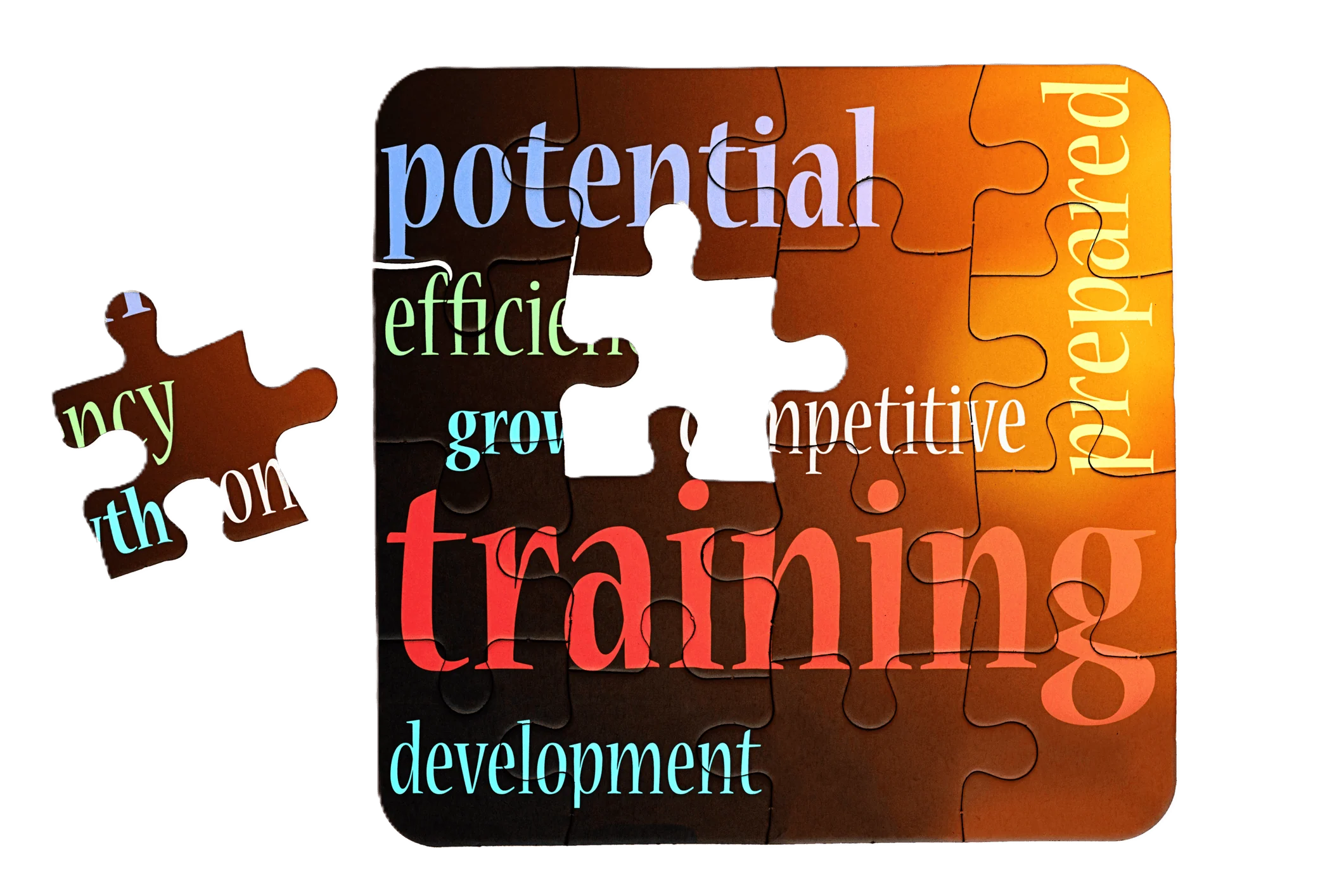AI Skills Are the New Baseline
You Don’t Need a $10K Bootcamp to Get Them
AI is everywhere now. Not only for software engineers, anymore. Marketing teams use it to write entire campaigns. Customer service teams use it to handle low-level tickets. Analysts use it to find trends in mountains of data. Whatever your field is, AI skills are quickly becoming as standard as email.
The good news? You can build them without draining your savings or quitting your job. Platforms like Coursera and edX are reporting a surge in people earning low-cost “micro-credentials,” they’re short and practical courses designed to be finished in weeks… not semesters.
This guide lays out our three-tier plan:
- Start free to figure out what you need.
- Invest small in credentials that really count.
- Let your employer (or a scholarship) cover the advanced learning.
Follow this, and you’ll go from curious to capable without wasting any of your time or money.
Closing the AI Skill Gap Now
AI isn’t replacing jobs overnight, but it is reshaping the ones we have. Jobs that once relied entirely on precise manual research, repetitive routine tasks, or basic analysis, now, expect you to work with AI tools.
Employers are quietly shifting job descriptions. A marketing role might now list “experience with AI content generation.” An HR coordinator might be expected to use AI to screen resumes. Even outside tech, being fluent in AI basics shows your adaptability, a trait more and more hiring managers value almost as much as technical skill.
Those who learn early gain an edge:
- Better pay, because you can do more with less time.
- Career mobility gives you access to the AI jobs that simply didn’t exist a few years ago.
- Job security in workplaces that are shifting and automating at faster speeds.
Closing the gap now means you’ll be ready when AI is no longer just a “bonus skill” but the standard requirement.
The Three Tiers
Instead of going straight into an expensive course, or getting lost in endless free videos that all say the same basic things… break your AI learning into these three, clear, stages.
Tier 1: Free Exploration
Start with no-cost resources to get comfortable with AI basics, terminology, and tools. Your only goal here is to figure out what’s relevant to your field.
Tier 2: The Affordable Creds
Once you know where to focus, invest in lower-cost certifications that directly relate to the employers you want to work for. These add structure to your learning and give you projects to show off.
Tier 3: Funded Specialization
If they’re available actually use your employer’s stipends, the tuition reimbursement, or scholarship programs to go even deeper. Specialize in an area that syncs with your career path so the time and money pay off better.
Following this progression keeps you from overspending, skipping steps, or collecting certificates that won’t help actually you get hired.

Tier 1: Exploration & Free Certificates
Before you spend a cent, get your footing. If you’re brand new to AI, or just not confident yet, take some time to explore. This is your low-risk “trial run”, testing the waters to see how AI could actually fit into your work or career plans.
Start with high-quality, free content
YouTube is full of “AI explainers,” but make sure you look for creators with a proven track record, people who show real workflows, not just clickbait-hype. Channels like Two Minute Papers or Data School, are pretty clear, and have beginner-friendly breakdowns.
Use trial periods wisely
Coursera, edX, and LinkedIn Learning usually have free trial periods. If they do… Pick one course and commit to finishing it within that trial window. It’d be a good idea to focus on the fundamentals like “Introduction to AI” or “Prompt Engineering Basics.”
Get free certifications
Grab a couple, or few, free certifications while you’re here. Google Digital Garage, Microsoft Learn, and IBM SkillsBuild have beginner-level AI courses that don’t cost anything, and you can usually finish in a few hours. Aim for two or three in this stage, enough to decide whether the topic clicks with you before committing to a paid track.
Explore free tools and communities
Play with these new tools! Pick something you’ve seen someone else do and start from scratch, but tweak things. You can browse OpenAI’s help docs, run through a free Hugging Face tutorial, or try a Kaggle notebook. Then join a Slack, Discord, or LinkedIn group where they share their real examples and tips. That can give you ideas you’d never think of on your own.
Your goal here: Learn the language, try a few tools, earn a couple of entry-level certificates, and figure out which skills feel most relevant. That way, when you move to paid learning, you know exactly what is worth the investment.
Tier 2: The “Affordable” Credentials
Once you know which skills really matter for your field, it’s time to add some more structure. And now, you will need to “put a little skin in the game.” Affordable certifications can give you a guided path, projects for your portfolio, and credentials that hiring managers actually recognize.
Start with Well-Known Providers
Google’s AI and Data Analytics certificates on Coursera run about $39 a month and can usually be wrapped up in just a few months if you stay consistent. IBM’s Applied AI Professional Certificate and Microsoft’s AI Fundamentals are also respected, and come with “hands-on” projects you can actually show off in your portfolio.
Pick Credentials with a Clear Payoff
Choose courses that leave you with something real. You want to have something like a working project, a case study, or a skill set tied directly to your field. If you can’t see an obvious connection to an employer’s needs, neither will they. It’s best to skip those ones.
Keep It Focused
One or two well-chosen certificates at this stage will do more for you than a dozen loosely related ones. Your goal isn’t to collect badges, though it can be really fun, it’s to build skills that will help open the next door.
Your goal on this tier: Earn some recognizable certifications that give you portfolio‑ready work and directly relate to jobs you want in the future. A good target here is 8 to 12 weeks total, and you keep spending under around $150, ideally.
Tier 3: Paid Specialization
By this level, you should’ve nailed the basics and earned a few affordable credentials. Now is time to go even deeper, hopefully without footing the entire bill yourself.
Use Employer Support
Lots of companies do have tuition reimbursement, professional development budgets, or annual stipends that go unused. You just need to ask your manager or HR person if they exist, then find out exactly how to get access them.
Find Scholarships and/or Grants
Industry groups, nonprofits, and even course providers offer funding for AI education. Programs like Women in AI, AI4ALL, and DataCamp’s scholarship initiatives can cover part or all of advanced training.
Slip Continuous Learning Into Job Offers or Reviews
If you’re starting a new job or going into a performance review, include learning support in the conversation. Framing it as “bringing more value back to the team” makes it an easier sell.
Specialize With Intention
Choose something where AI crosses over with your career path, AI in marketing, AI for healthcare analytics, or AI-powered manufacturing. Specialization makes you way harder to replace and a lot easier to promote or give a raise to.
The final goal: Use outside funding to cover advanced training that builds rare, in-demand skills directly tied to your career growth. Finish with a specialization you can clearly position as your professional edge.
Keep Current Without Burning Out
AI evolves fast enough to make you feel like you’re always a step behind (literally me, all the time. And I use AI daily!). The trick is to stay informed on what really relates to you. Trying to keep up on all things AI is nearly impossible without turning learning into a second fulltime job.
Build Your Source List
Pick some newsletters, podcasts, or blogs you really trust. A few good options: The Batch by deeplearning.ai, Towards Data Science, or the AI Breakdown podcast. Too many sources will bury you in advertisements, clickbait, hype and loud noise without teaching you anything.
Set a Manageable Pace
Like your source list, you don’t need to chase and master every new AI tool, either. Stick to one hands-on project or experiment each quarter. Apply what you’ve learned before adding more to your plate.
Avoid Course Hoarding
It’s tempting to sign up for everything you can, but unfinished courses waste your time and your attention. Choose courses and projects carefully. Always complete what you start, then move on.
Continuous Goals: Keep your skills sharp with a steady trickle of new knowledge, at least every quarter… You want to learn enough to keep growing, but not so much that you end up stalling-out from overwhelming burnout.
FAQs
Do I need to learn to code for filling the AI skills gap?
No. Plenty of AI tools work without writing a single line of code. “Vibe coding” is the term for, well… codeless coding, and it’s blowing up. It’s especially showing up in business, marketing, and operations.
Coding is great if you want to really understand and build AI systems or dive deep into emerging data science, but that’s definitely not the only path anymore.
How much time should I set aside each week?
A few hours is plenty enough. Three to five focused hours can get you moving at a steady pace without draining your energy. If that’s too much to block off, break it up into smaller chunks throughout the week (one-hour to two-hours can work too).
What if my job has nothing to do with AI right now?
Learn anyway. Entire industries are using AI faster than most people expect, and the shift can happen nearly overnight. Having those skills ready before the change keeps you as one leading the charge, not scrambling to just catch up.
How do I know if they are really worth the money?
Look at where the certificate comes from, does the provider show up in job descriptions you care about? Check how recent the reviews are, and whether the course ends with a project or example you can actually use in a portfolio.
Can I switch AI focus areas later?
Absolutely. Skills like prompt design, workflow automation, and AI-assisted research travel well between fields. Your early work is about building a foundation you can adapt, not locking yourself into one niche.




